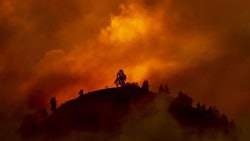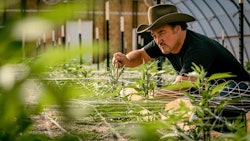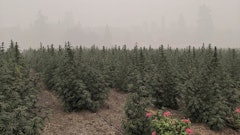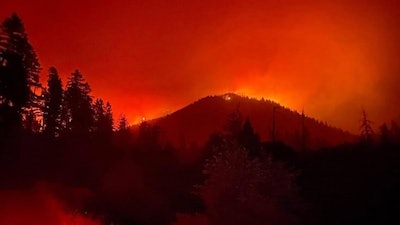
On a dire Labor Day in the Okanogan Valley of Washington state, Terry Taylor and four family members fought the Cold Springs Fire away from Okanogan Gold. Taylor, the cannabis farm’s CEO, and the group diverted the fire away from his fenced-in crops Sept. 7.
Taylor dug fire line—a path meant to slow or stop a fire—around his 38 acres of property. When the fire reached the fence and caught a section of it on fire, his daughter’s boyfriend kicked a section of the fence down.
As a previous firefighter and engine boss, Taylor knows about fires. He spent about three years working as a firefighter with the U.S. Forest Service, then after taking a different career path, worked as an engine boss, a supervisory role on a fire engine.
"Usually, the same thing would have been done with like two hand crews and six engines—and a hand crew’s like a 30-man crew,” Taylor said. “So, the amazing thing is that we did it with like four people.”
To reach the property, he said the fire hopped over two lanes of U.S. 97 and the Okanogan River, the latter of which is roughly 1,500 to 2,000 feet where it comes up against his property.
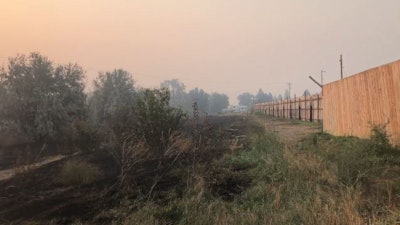
At Okanogan Gold, Terry Taylor dug fire lines next to his farm's fence and farther from its perimeter.
Before the fire jumped the river, Taylor received a warning. “The sheriffs that came in and told us, 'This is your last chance. If you don't go, we're not sending any resources. You're on your own,’” he said. “So, that's when we knew that we were committed.
“They did watch from a distance. We could see the sheriffs; they were still watching us. Just to make sure, I'm sure they would have called in and done what they could have if they would have seen us really get burned over.”
With fires raging across the West Coast, destroying power lines and requiring heavy resources, there wasn’t any water nor professional help. More than 4 million acres have burned so far due to more than a dozen wildfires across California, Oregon and Washington.
It’s too soon to tell what the full impact will be for the cannabis industry, especially for the sun-grown cultivators along the West Coast. Julie Graham, spokeswoman for the Washington Liquor and Cannabis Board said the following:
“We have had reports of one grower in Whitman County who has reported an impact from the fires, but we've not yet had any of our staff report to headquarters about any other impacted growers or retailers. So, basically what we've done is just asked our staff that if they hear anything from growers, to document that, and we'll be keeping track of it.”
RELATED: California Wildfires Continue to Ravage State Agriculture, Including Cannabis Farms
Taylor has watched as nearby houses have burned, one of which was an old structure he previously owned with a business partner; Taylor had sold his half. He said of his business partner: “He’s okay with that because that was one of the alternatives he was thinking about doing, was just tearing it down to build it on that frame.”
Another house burned in about 10 minutes early Sept. 8, he said. “At 4:30 in the morning, that one blew up, and it scared me and my wife—and it made this evil sound because it was propane tanks that blew up. And it looked just like a literal fireball.”
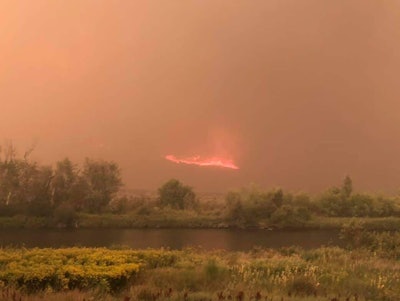
If Taylor didn’t have his tractor, he said he wouldn’t have been able to dig fire line, and his entire operation would have gone up in flames. Instead, one plant’s fan leaves got singed.
“And not only that, it would have went into the neighborhood up above us, and there would have been more houses taken out, too,” he said.
Eleven cannabis grows—each between one and two acres—and three processing centers comprise Okanogan Gold’s operation. Taylor either owns or rents all of them.
Not only were these businesses at risk of destruction, but so was Taylor’s house. He cleared brush with his tractor to stop the fire from engulfing it.
“I’ve been on a lot of fires, and I've been around a lot of extreme fires,” Taylor said. “But when it's coming at your own house and your own place—that's why those guys all have the heart because it was our whole livelihood and everything. It would have been just over. We have 30 employees, and they all are counting on us.”
Mounting a Defense in Oregon
Although wildfires are an unfortunate reality for Nathan Howard and the team at East Fork Cultivars, as well, they thought they had lost everything this time.
The Slater Fire that has been raging along the Northern California and Southern Oregon border has been consistently less than a mile away from East Fork Cultivars, Howard said. Howard and his brother, Aaron, co-founded the business, where they cultivate sun-grown cannabis and craft hemp on a 33-acre property.
Each day, they wonder if the drying and curing barns, the three family homes—including Aaron’s—and other structures around the property will still be standing, and their fields of cannabis will still be growing when they return.
They have fled Takilma, Ore., two times since the level III mandatory evacuation took effect. But Howard, his brother and CEO Mason Walker keep going back. Like Taylor in Washington, they believe it’s up to them to save their business and property.
RELATED: East Fork Cultivars Sets Itself Apart From the Oregon Marketplace
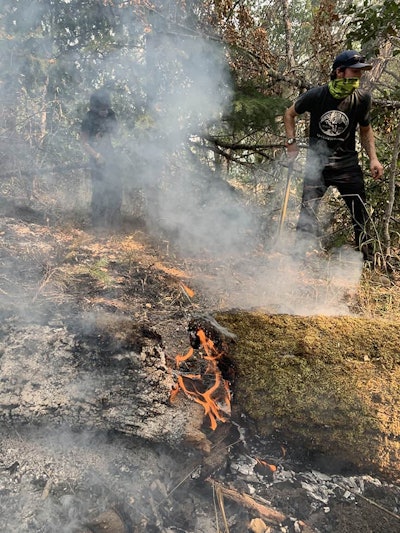
After first leaving the area Sept. 8, they returned a couple days later with gas masks, chainsaws and axes, to “mount a defense,” Nathan Howard told Cannabis Business Times and Hemp Grower, digging 8-foot-wide fire lines using a tractor they converted into a giant rototiller along the perimeter of their farm to expose the soil and remove the brush that fuels the blaze, he said.
“We essentially are covered on three sides, to the south, east and west. The fire is approaching on all sides, and the fire lines to the east is the latest work to be done,” Howard said.
They also transferred their industrial irrigation pods from their cover crop fields to the edge of their farm to create yet another moat-like water barrier, hoping the moisture would stymie the spread of the powerful flames that have engulfed more than a million acres in the state.
Several cannabis businesses in Oregon have been leveled by wildfires, said Mark Pettinger, spokesman for the Oregon Liquor Control Commission’s (OLCC) marijuana division. As of Sept. 11, 64 cannabis licensees had notified the OLCC that they either received evacuation orders or had initiated a product transfer to another licensee, Pettinger said. He noted that this is not a total count but is rather based on data that has come in.
“We’re toggling between wanting to defend the farm and possibly evacuating on a moment’s notice if the fires get too close or become unpredictable,” Howard wrote on the company’s Instagram page, which he has been updating regularly as they continue to watch the weather, hope for the best and do as much as possible to preserve their farm and the genetics they have carefully cultivated during the past five years.
Most of the images and videos Howard has posted are of the fields and greenhouses, where cannabis is now growing under a hazy, peach sky. Howard narrates the current situation in Takilma and the Illinois Valley region and how the farm has been impacted, likening the eerie, menacing conditions to the apocalypse. At one point, Howard and the team ventured a little closer, capturing a video of a spot fire just up the road from their farm.
“And here’s the state of affairs all across southwest Oregon, Oregon and the West Coast. Fires freely burning,” Howard says in the video before suggesting to Walker that they put the fire out. They did.
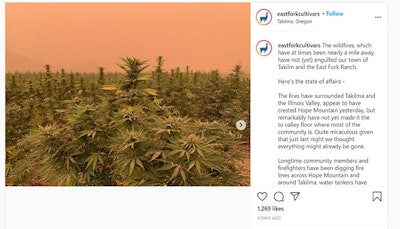
Neighbors have also been digging fire lines, which has likely helped slow the spread of the blaze and protected their property, Howard said. But they are taking all precautions – working through the night to dig fire lines, remove trees and brush around structures and flooding the gutters of their greenhouse, homes and other buildings to prevent one tiny ember from growing into a giant flame.
“We’ve had fires in the past,” Howard said, recalling a particularly bad season in 2018 and how his brother Aaron has volunteered to help fight the seasonal fires. Pettinger also noted that season, but said he recalls growers were more concerned about smoke's effect on their crops than total losses.
Either way, those wildfires were a harbinger of what was to come—a further increase in the number and severity of blazes.
“This is definitely the worst,” Howard said. “People have been [fighting fires] so long it’s ingrained in their DNA, by doing it and being around old timers who have been through this before.”
The timing and magnitude of the fires are particularly detrimental for outdoor cannabis cultivators, as the outbreak happens to coincide with the beginning of harvest and what has been a very dry season, combined with the economic impacts of the coronavirus pandemic.
After securing their fields, which include type I, II and III cultivars, as best they could, transferring some of the flower that had already been harvested, gathering as much of their seeds, clones and as many of their most valuable cultivars as possible, the team fled again on Sunday. But on Monday, Howard was driving along I-5, where it was “raining ash,” creating a thick, smoky fog that made it difficult to navigate and see anything beyond 30 yards ahead as he headed back to East Fork.
For now, Howard said they will continue to collect clones, seed and as much flower inventory as possible to be sure if they do lose everything, they have the genetic library to rebuild. They’re also moving some of their most valuable equipment, and what they can’t move, they are storing in a shipping container that they believe, they hope, is fire-proof.
Their business is not the only aspect of their livelihood that is at risk. There are the three family homes on the property and more nearby, plus a handful of barns, some that include state-of-the-art climate control equipment for drying and curing.
There’s also a good possibility that, thanks either to their efforts, good fortune, or a little bit of both, the fire will not destroy everything they’ve built. And right now, there’s hope that the worst is behind them. They’ve been working to help their neighbors secure their properties, put fires out, and sometimes sleeping just an hour or two at a time. Everyone is working together and chipping in where they can, Howard said, noting that “colleagues, friends, and people we work with in the broader cannabis trade have made us a bunch of food. Chili, soup, corn bread, ziti, burritos, vegan sandwiches...”
Looking ahead, they must make up for lost time and meet an incredibly tough deadline due to a compressed harvest season.
“If we get there now and feel confident the fire lines will hold, there’s also part of us that thinks, if we do all of this work, and the fire doesn’t come, we still have harvest that’s supposed to begin next week … and varieties that need to be harvested on [Sept. 28,] that’s when we’re slated to go into full swing harvest,” Howard said. “So we’re battling against the emergency, which is competing against the very real work should it not burn down, with a mass harvest, possibly our largest harvest to date after five years. And we are behind.”
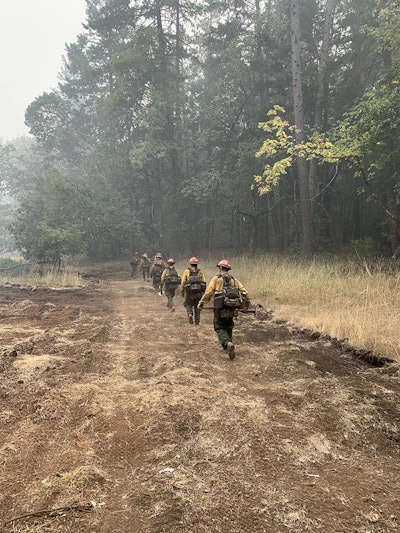
Howard said many people have asked him what effect the toxic air, smoke and falling ash will have on the cannabis plants.
“Ash and smoke shouldn’t harm the plant or flower,” he said, adding that mold, usually a threat for cultivators, can’t tolerate the conditions. “We have several cultivars that are beyond ready to harvest and, even with the protection ash provides, will soon begin to mold. So feeling anxious about the harvesting we need to be doing, anxious for the rains to come later this week, and anxious that the rains might exacerbate botrytis.”
But he said they will be ready and will return to harvesting plants when they can.
“Assuming this all goes well, we’re going to get an armada of electric-powered leaf blowers and will remove ash from the flowers and trichomes,” he said. “We may burn down. We also might not burn down. Either way, we are committed to moving forward.”
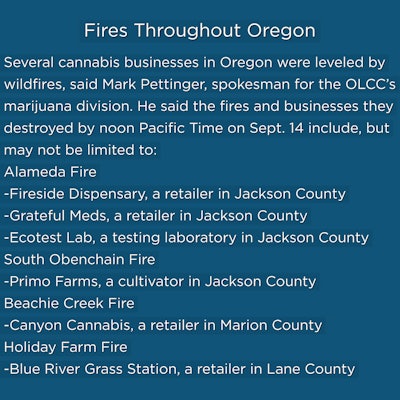
Preventative Measures, Relief
Taylor said there are other strategies growers can follow to protect their properties, other than the immediate efforts he and the East Fork Cultivars team took to stave off the flames.
“If they don't have the knowledge, they should get the simple knowledge of how to fight fires, which is remove all the fuel away from your grows, within 100 to 200 feet if you can,” Taylor said. “But if you can't, at least give yourself a 10, 20-foot buffer that there's no fuel, nothing that can be consumed.
“Those are simple things that anyone can do. ... If someone wouldn't have had the knowledge, they would have had no idea what to do. So, it might even be wise for them to hire a fire consultant to tell them what to do.”
Looking ahead, Taylor said he will take additional measures. These will include pouring gravel around diesel tanks and gas tanks and installing sprinklers around the fence to be able to water the land 30 feet from its perimeter.
“We know we're going to keep all our lawns mowed and try to keep them green all the way around,” he said. “We have too many areas to try to keep everything green everywhere. But we can keep it green on the edges, which would have given us the ability to protect our farms.”
Growers in at-risk areas should also consider buying trucks with a water tank, pump and hose attached, Taylor said.
He has another piece of advice for growers in fire-prone regions: “They may want to consider moving, because these fires seem to be coming. It's just a matter of when.”
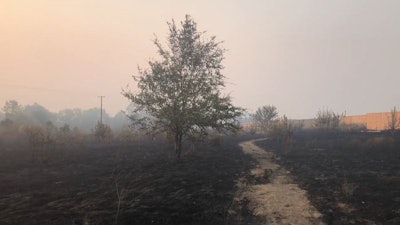
For those who have already established businesses in the region, many wonder what relief will be available to them.
“We don't have the authority or the rule of offering any sort of relief package,” says Julie Graham, Washington State Liquor and Cannabis Board spokeswoman. “That would have to come either through the state or through some sort of a designation, like a declared emergency, through their county and the state, in order for them to qualify for any sort of relief package.”
In Oregon, Pettinger said licensees in the state should check in with the OLCC when possible, adding: “They've got a lot to worry about. Their safety and lives are more important than them reporting to us the circumstances under which they had to flee. But we do want them to make contact with us.”
For now, Pettinger recommends that growers protect their product, if possible.
“Two years ago, we had something similar happen, certainly not to this magnitude, but there were some fires in Southern Oregon, and there was a need for folks to be able to transfer their product,” Pettinger said. “So, this is the advice that we gave them then, and this is the guidance that we [are giving] them now.”
While it’s not certain if any relief will be available to the cannabis industry from the federal government, Pettinger said the OLCC will provide operational assistance.
“We will work with them to get them back operational, as they're able to do other things,” he said. “For many of them, that might be relocating to a new property. We'll do everything we can to get them reestablished.”









